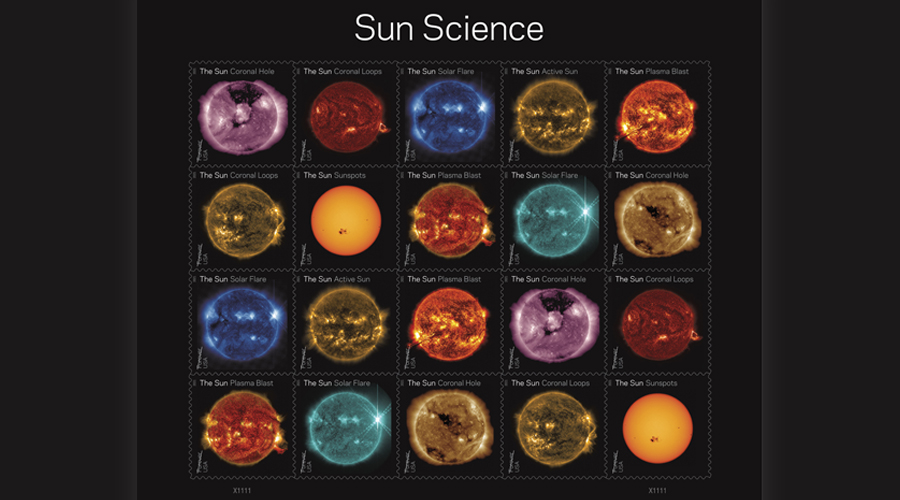The new Sun Science stamps feature photos taken by NASA’s Solar Dynamics Observatory, then colorized to highlight important phenomena. Here are the six processes depicted.
1. Active sun. This golden-hued stamp features a 2014 image that highlights the sun’s transition zone — a 60-mile area about 1,300 miles from the sun’s surface that goes from 40,000 degrees Fahrenheit to 1.8 million degrees. The unusual temperature change is a mystery to scientists. Why does the temperature get hotter farther out?
2. Coronal holes. The corona is the sun’s outer layer. Cooler, less dense areas that are magnetically open, allowing solar winds to escape the corona, are called coronal holes. Two stamps depict them: The purple is from 2016 and is calibrated to 3.6 million degrees F; the light yellow was taken in 2011 and is calibrated to 1.8 million degrees F.
3. Coronal loops. These are formed when solar material travels along magnetic fields to form arcs above the sun. The loops are thought to be a key to solving the mystery of the sun’s unusual temperature changes. They are often found in active solar regions and can exist briefly or last for weeks. Two stamps depict coronal loops: The yellow is from 2012 and the red is from 2015.
4. Plasma blasts. The website Livescience describes a plasma blast this way: If you think of solar winds as the breath of the sun’s corona, plasma blasts are its energetic burps. Also known as coronal mass ejections, these proton-electron clouds are carried upward by solar winds, belched out at astronomical speeds. Two orange-tinted stamps depict the phenomenon, one from 2012 and the other from 2014.
5. Solar flares. Solar flares are bursts of electromagnetic radiation that last for brief periods of time — minutes or hours. Solar flares usually do not penetrate Earth’s atmosphere, but when they do, there can be interference in communications systems. Two stamps, teal and blue, show the same flare from 2011. The teal image highlights the extreme heat of the flare, while the blue image highlights a region of heightened magnetic activity — areas where flares often originate.
6. Sunspots. Sunspots are cooler areas in the sun’s photosphere, its base atmospheric layer. They can be several Earths in diameter and crop up in regions of heightened magnetic activity. The website Space.com likens sunspots to the cap on a soda bottle: When you shake a soda, the contents might explode through the cap. When there are areas of heightened magnetic activity on the sun, plasma blasts or solar flares could erupt through a sunspot.
